Critical Role: Call of the Netherdeep isn’t just a deep dive into the world of Exandria that takes player characters to an eldritch underwater realm. The adventure also pits the characters against a group of rivals who adapt and grow over the course of their travels, matching the characters in strength and ambition.
Here's a look at what we know about the rivals ahead of the adventure's release on March 15:
- Rival factions racing to the Netherdeep
- Ayo Jabe, leader of the rivals
- Dermot Wurder, the rival squad’s cleric
- Irvan Wastewalker, the hardy rival rogue
- Bringing rival NPCs to life
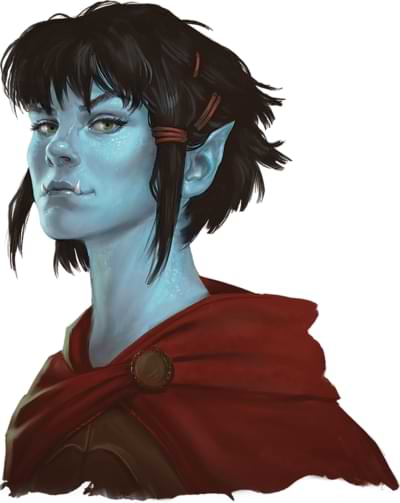 Rival factions racing to the Netherdeep
Rival factions racing to the Netherdeep
According to an interview with Call of the Netherdeep co-lead designer and Exandria creator Matt Mercer, the story’s rivals were devised to emphasize the fact that the player characters aren’t the only adventuring party in the world. He has gone so far as to call the rivals a “ticking clock” meant to keep players motivated and invested in the campaign’s plot.
In the same way that characters level up, the rivals will grow stronger over the course of the campaign. Depending on the decisions that the party makes in their interactions with these characters, their personalities will evolve as well.
Will the rivals become cheerful frenemies, despicable villains corrupted by ambition, or something in between? The choice is up to the whims of the gaming table, adding a layer of dynamic choice in Call of the Netherdeep that sets it apart from many other Dungeons & Dragons adventures.
Ayo Jabe, leader of the rivals
Ayo Jabe, the leader of the band, is a chaotic good water genasi and a hard-hitting ranger. Her challenge rating is 3, keeping her in step with the player characters at the start of the adventure. Expect her power to grow over the course of the adventure.
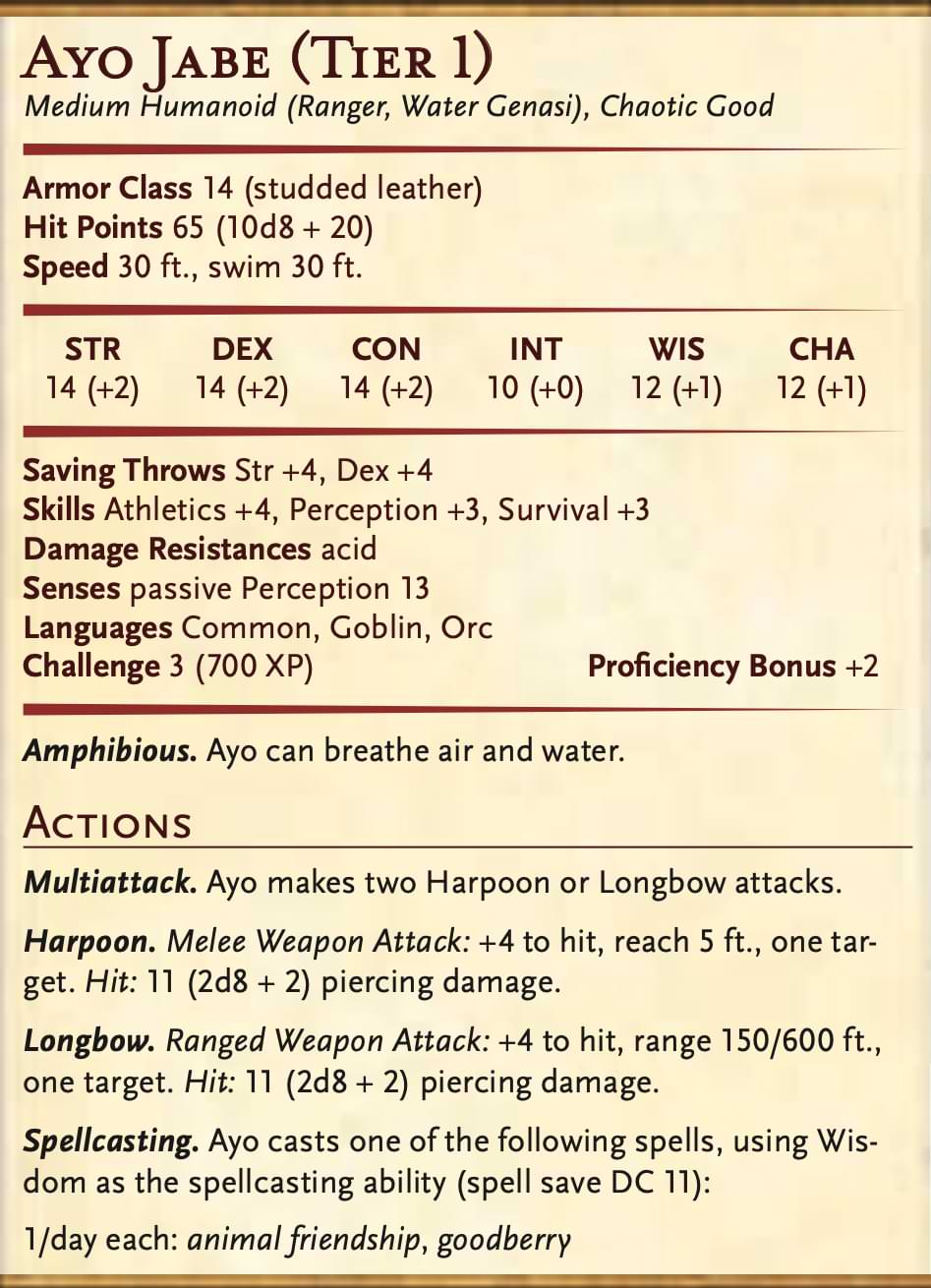
- Ayo Jabe wields a harpoon and a longbow, and she can utilize Multiattack with either weapon. On average, two of Ayo’s harpoon strikes or two longbow shots will deal 22 piercing damage. Dungeon Masters shouldn’t be afraid to place her in the front ranks of the rivals while in combat, swinging her harpoon to and fro to let the characters know that they aren’t the only protagonists in town. Her role as the rival leader means that she’ll also be at home from the back ranks, targeting opponents with her longbow while giving orders.
- At least at the onset of Call of the Netherdeep, Ayo’s more of a combatant than a magic-user. Nevertheless, her two spells—animal friendship and goodberry—can be great for roleplaying possibilities, especially when her crew crosses paths with the characters. Perhaps the party also has a ranger with a fierce bear as their animal companion, for instance. Ayo can put this creature at ease with animal friendship, maybe setting the stage for both rangers to eventually become friends. In another scenario, if both the characters and the rivals end up fighting the same enemies, Ayo could use goodberry to pass out healing treats at the end of the combat, building solidarity between both adventuring groups.
Dermot Wurder, the rival squad’s cleric
Dermot Wurder is a lawful good goblin who wears heavy armor and is prepared to defend his friends in all manner of dangerous situations. Like Ayo, he also sports a challenge rating of 3, and his skill set is centered around the typical abilities of a cleric—tanking and healing.
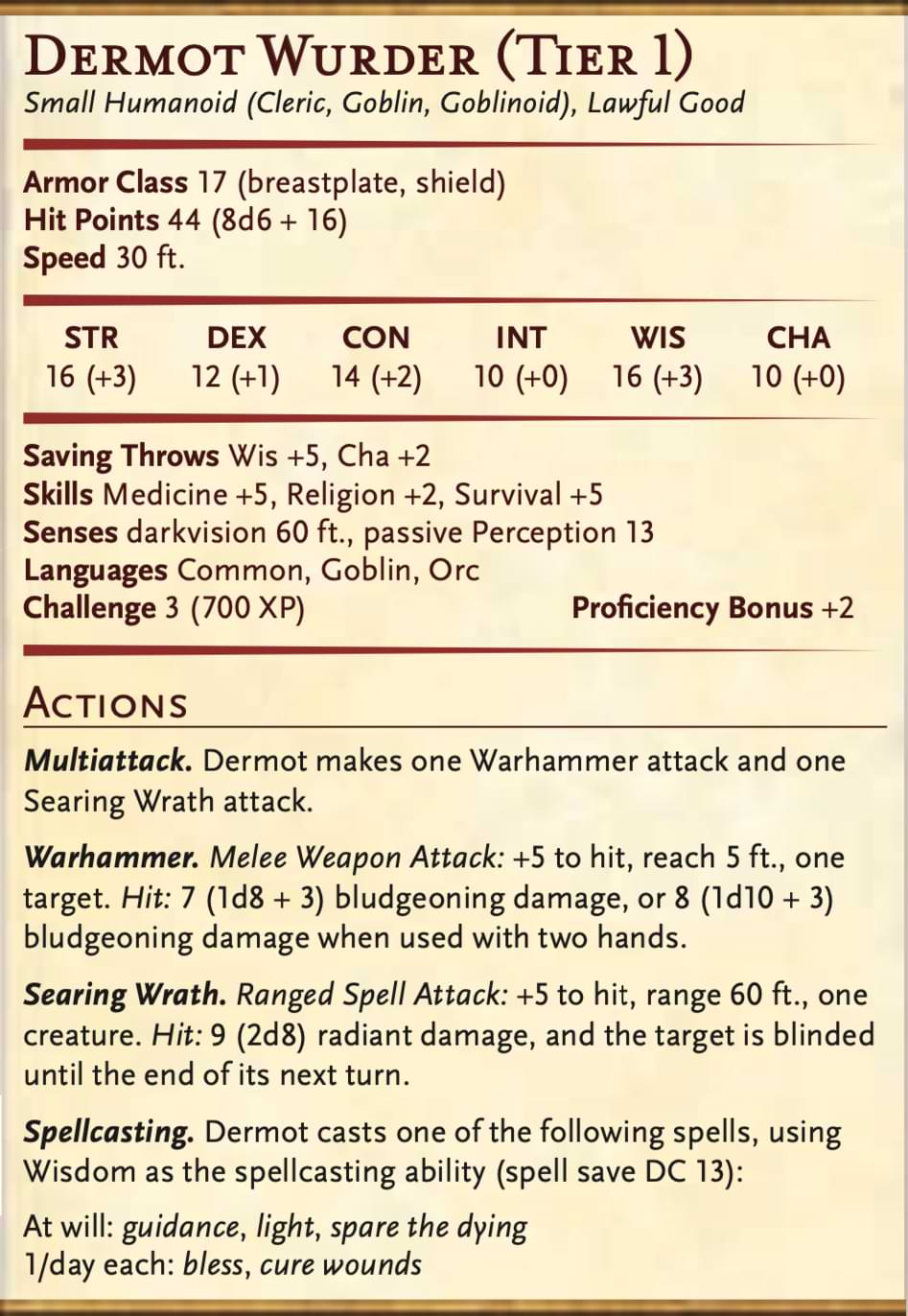
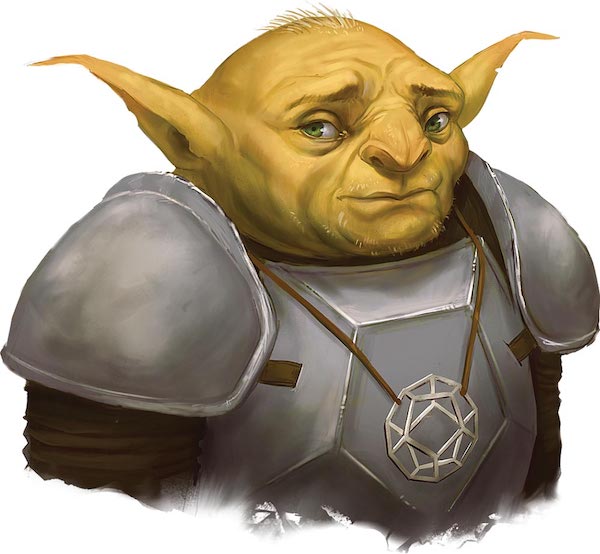
- Dermot swings a warhammer that does an average of 7 or 8 damage per strike, depending on whether he’s using one or two hands. He can combine this strike with his Searing Wrath ability for a potent Multiattack that deals 9 extra radiant damage on average, blinding creatures until the end of their next turn. If you’re running Dermot in combat against your players, make the most of this combo to harass the heaviest damage dealers, since there’s a good chance that their characters will be reliant on sight to attack.
- Dermot boasts a solid selection of cantrips, including guidance, light, and spare the dying, and he can cast bless and cure wounds once a day. Prior to combat, Dermot will bless all of his companions, and once combat begins he’ll carry out the usual cleric routine of curing his friends and stabilizing them if they fall.
- If the rivals of Call of the Netherdeep become friends rather than foes, consider having Dermot cast guidance or spare the dying on one of the player characters as a sign of trust and goodwill. Alternatively, if both the characters and the rivals are navigating the same dungeon together, Dermot’s light can shine the way ahead.
Irvan Wastewalker, the hardy rival rogue
Irvan Wastewalker is a fellow who gets hit a lot but always stands back up, though hints of him possessing a complicated backstory indicate that he’s deeper than just a rough-and-tumble brawler. His skill bonuses are centered around Acrobatics, Deception, and Stealth, though his high hit points give him a touch more durability than the average rogue.
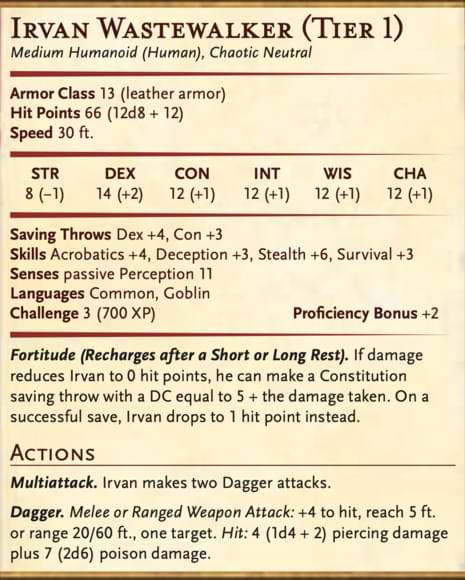
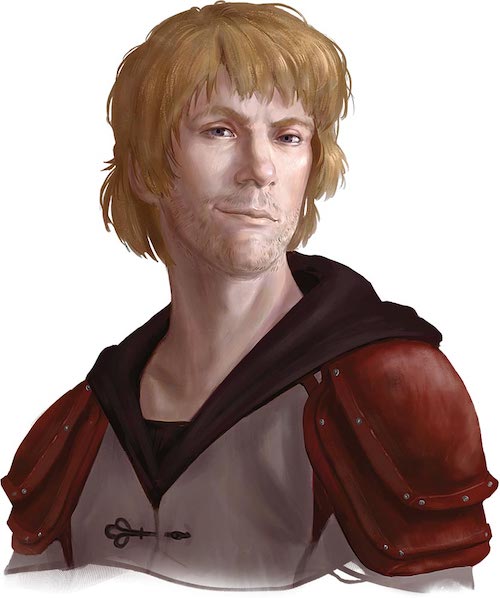
- Irvan’s Multiattack is a standard double-dagger stab. While he doesn’t get any Sneak Attack bonuses, his strikes do inflict an average of 7 points of poison damage. If the characters are up against Irvan in combat and performing poorly, you may want to hint that his dagger strikes cause a twinge of stinging pain. Clever party members can take this as a hint to cast a resistance-inducing spell, like protection from poison.
- Fortitude is Irvan’s more interesting ability, letting him remain at 1 hit point when damage might otherwise knock him out—provided he can pass a Constitution saving throw. This is similar to the barbarian’s Relentless Rage ability or the half-orc’s Relentless Endurance, but the varying DC makes it not nearly as reliable.
- Irvan should be played in combat like a typical rogue who gets in close to stab away, but his Fortitude ability makes him unusually careless. Play him as a swingy fellow who either bounces back from near-death experiences or flounders pathetically due to an inability to make his DCs, and be sure to have the other rivals exasperatedly cry out, “Not again, Irvan!” if he ever dramatically collapses more than once during a fight.
Bringing rival NPCs to life
Even if you aren’t running Call of the Netherdeep, rivals can be an excellent addition to any campaign. Try the following suggestions to bring rival NPCs to life:
- Go for the childhood-friends-turned-bitter-rivals angle. Perhaps these NPCs grew up in the same backwater village as the party, and everyone once competed together in friendly games of goat-ball. Then, one day, the party members were selected by their village elder as chosen ones for a grand quest, and the rivals were left behind. Not content to let the party outshine them, the rivals have now banded together with a collective chip on their shoulders. This trope is seen time after time in popular fiction—particularly in shōnen anime—and it’s one that most gaming tables are likely to recognize and appreciate.
- Turn the player characters into the bitter group left behind. The rivals can be childhood comrades who have gone corporate, found a wealthy patron, and morphed into spoiled elitist adventurers. Or maybe they’re simply more skilled guild compatriots or schoolmates (perfect in a setting like Strixhaven: A Curriculum of Chaos). To use a Pokémon analogy, the rivals are Gary Oak to the party’s Ash Ketchum, and their sheer snobbery can provide an excellent motivator for the characters to outclass and outdo them. If you really want to hit home the Pokémon analogy, every time the party cross paths with their frenemies, be sure to have the rivals sneer “Smell you later!”
- Turn the rivals into recurring foes hired by the campaign’s big bad. The rival NPCs can show up at multiple points in the adventure to antagonize the party, always fleeing before the characters get the chance to kill them in combat. (For a grimdark—or possibly comical—approach, they can also die and be resurrected by your campaign’s evil antagonist as sentient undead, who are just as annoying as they were in life.) Maybe at some point in the campaign, these recurring rivals can even switch sides if the characters convince them to abandon their sordid employer for a better cause. For inspiration, look at anti-heroes in popular media who toe the neutral line and are too memorable to keep dead—mercenaries like Star Wars' Boba Fett or the DC Universe’s Deathstroke are great examples.
Friends or foes? The choice is yours
Whether you're planning on pitting Ayo Jabe and her companions against the characters or simply hoping to have more friendly faces in your back pocket, rivals are a fantastic way to add tension and competition to your campaign. For more on Ayo’s crew and all the other mysteries that lurk beneath Exandria’s waves, be sure to preorder Call of the Netherdeep here on D&D Beyond.
Jeremy Blum (@PixelGrotto) is a journalist, gaming blogger, comic book aficionado, and fan of all forms of storytelling who rolled his first polyhedral dice while living in Hong Kong in 2017. Since then, he's never looked back and loves roleplaying games for the chance to tell the tales that have been swirling in his head since childhood.








-
View User Profile
-
Send Message
Posted Feb 28, 2022Why does a level 10 medium sized Ranger deal 2d8 with a longbow, and only have 2 spell slots?
If the NPCs are each CR 3, shouldn't they mow down a party of Tier 1 PCs? They are a rival adventuring group, so the encounter should be 4-6 of them against the players, yes?
-
View User Profile
-
Send Message
Posted Mar 1, 2022They're "rivals" not strictly "enemies". I haven't read the book, but I infer that conflict between the PCs and Rival groups is supposed to be largely RP focused, competing to reach the same goal first, setting traps to slow each other down, forming temporary/ tenuous alliances, etc. You COULD attack the group of seasoned adventurers in an attempt to wipe out the competition, but if you succeed you basically remove any use for the Rival mechanic immediately, and so the difficulty is likely to encourage exploring other approaches.
-
View User Profile
-
Send Message
Posted Mar 4, 2022I didn't read it that way at all and I tend to agree with their take on it. I'd love to see more than just and advert written out and more well thought out and insightful articles exploring various ideas using the upcoming content. You can calm down with belittling someone with an opinion different than your own. At least their observation is a conversation starter. You've contributed nothing helpful
-
View User Profile
-
Send Message
Posted Mar 4, 2022I didn't read it that way at all and I tend to agree with their take on it. I'd love to see more than just and advert written out and more well thought out and insightful articles exploring various ideas using the upcoming content. You can calm down with belittling someone with an opinion different than your own. At least their observation is a conversation starter. You've contributed nothing helpful
-
View User Profile
-
Send Message
Posted Mar 13, 2022What kind of looney toon DM only hints that a player took poison damage, instead of saying they took poison damage?